High injection molding costs1 eating into your profits? Worried that cutting costs means lower quality parts? Discover expert strategies to save money effectively and keep your standards high.
You can significantly reduce injection molding costs by optimizing material choices, simplifying designs using DFM principles2, investing in durable tooling3, and streamlining production processes. These steps ensure quality isn’t compromised while improving your bottom line.
Navigating the world of injection molding costs can be tricky. I’ve seen many clients, just like Jacky, grapple with balancing their budget against the need for high-quality, reliable parts. The good news is that it’s entirely possible to cut down on expenses without taking a hit on the final product. It all comes down to smart choices and a bit of foresight. Let’s explore some of the most effective strategies I’ve learned and implemented over the years at CavityMold to help businesses Master Molding Right.
How Can Optimizing Material Selection Cut Your Molding Expenses?
Wrong material choice inflating your part costs? This common oversight can unnecessarily drain your budget without adding real value to the final product.
Selecting the most cost-effective polymer that still meets all functional and aesthetic requirements is crucial. Over-specifying materials is a frequent, expensive mistake in injection molding projects I see.
Diving Deeper: Smart Material Choices for Cost Efficiency
Choosing the right plastic resin is one of the first places I look for potential savings with clients. It’s a balance. You need a material that performs, but you don’t want to pay for properties you don’t actually need.
### Choosing the Right Resin Grade:Not all grades of a particular polymer (like Polypropylene or ABS) cost the same. Some have enhanced UV resistance, higher impact strength, or specific flow characteristics. If your part is for an indoor application with no significant impact requirements, a standard, less expensive grade might be perfectly suitable. I always ask Jacky to clearly define the must-have versus nice-to-have properties.### Considering Recycled or Regrind Materials:Depending on the application’s aesthetic and structural demands, incorporating a percentage of high-quality recycled or in-house regrind material can lead to substantial cost reductions. Of course, this needs careful control to ensure consistency and part integrity, but for non-critical components, it’s a viable option. We always test this thoroughly.-
### Impact of Material on Cycle Time and Tool Wear:Some exotic or highly filled materials can be abrasive, leading to faster tool wear and more maintenance downtime – a hidden cost. Others might require longer cooling times, increasing cycle times and thus per-part cost. A slightly more expensive but easier-to-process material can sometimes be cheaper in the long run.
Here’s a very general idea of relative costs for common materials (costs fluctuate!):Material Type Relative Cost Key Considerations Polypropylene (PP) Low Good chemical resistance, flexible Polyethylene (PE) Low Cost-effective, good for containers Polystyrene (PS) Low-Medium General purpose, can be brittle ABS Medium Good impact strength, versatile Polycarbonate (PC) Medium-High High impact, transparent, good for lenses Nylon (PA) Medium-High Strong, good wear resistance PEEK Very High High-performance, high-temperature applications Careful evaluation here can save a surprising amount.
Can Simplifying Your Part Design with DFM Really Lower Injection Molding Costs?
Are complex part designs leading to sky-high mold costs and production headaches? Unnecessary features often cause manufacturing difficulties and inflate expenses significantly.
Yes, absolutely. Simplifying part geometry through Design for Manufacturability (DFM) principles dramatically reduces mold complexity, material usage, and cycle times, directly lowering your overall injection molding costs.
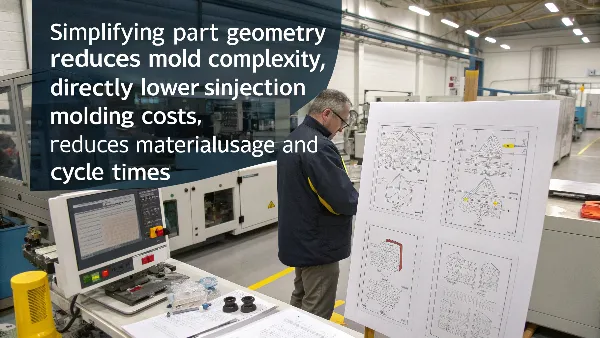
Diving Deeper: The Power of Design for Manufacturability (DFM)
DFM is a cornerstone of cost-effective injection molding. I often work closely with designers like Jacky on DFM reviews before a single piece of steel is cut for the mold. It’s about making the part easier and cheaper to produce without losing function.
### Eliminating Unnecessary Features:Every feature on a part can add complexity to the mold. Undercuts, for example, often require side-actions or lifters in the mold, increasing its cost and maintenance. Ask: Is this undercut really necessary, or can the design be altered to achieve the same function without it? Sometimes a small design tweak can eliminate a very expensive mold feature.### Striving for Uniform Wall Thickness:Parts with uniform wall thickness fill more easily, cool more evenly, and are less prone to defects like sink marks or warping. This can lead to faster cycle times and lower scrap rates. Thick sections take longer to cool, extending cycle times.### Incorporating Adequate Draft Angles:Draft angles (a slight taper on vertical walls) are essential for easy part ejection from the mold. Insufficient draft can lead to parts sticking, damage during ejection, and slower cycles. Adding proper draft is a simple DFM fix with big benefits.### Designing for Efficient Ejection and Gating:Thinking about how the part will be gated (where the plastic enters the cavity) and ejected can also influence DFM. Good gate location can improve filling and reduce cosmetic issues. Well-placed ejector pins ensure smooth part release.
We at CavityMold always emphasize that the design phase is the cheapest place to make changes. A few hours spent on DFM can save thousands down the line.Why is Investing in High-Quality, Durable Molds a Smart Cost-Saving Move?
Tempted by a significantly cheaper quote for your injection mold? Be careful, as this often leads to much higher long-term expenses due to frequent repairs, poor part quality, and production downtime.
High-quality molds, though requiring a larger initial investment, reduce overall costs over time through lower maintenance, fewer part defects, significantly longer operational life, and consistent, reliable part quality.

Diving Deeper: The Long-Term Value of Quality Tooling
I’ve seen it happen: a client opts for a very cheap mold from an unproven source to save money upfront, only to face constant issues. The "savings" evaporate quickly. Investing in a well-made tool from a reputable molder like CavityMold is usually more economical in the grand scheme.
### Mold Material Matters:The type of steel used for the mold is critical.- P20 Steel: Often used for lower to medium volume production runs. It’s easier to machine, making the initial mold cost lower.
- H13 Steel (or similar hardened tool steels): More expensive but much harder and more durable. Ideal for high-volume production, abrasive materials, or when very long tool life is required. They resist wear and maintain precision longer.
- Stainless Steel: Used for molds running corrosive materials (like PVC) or for medical applications requiring high cleanliness.
### Precision Machining and Construction:A quality mold is built with tight tolerances, excellent surface finishes in the cavities, and robust mechanisms for any actions (slides, lifters). This precision translates to consistent part quality and reliable mold operation.### Benefits of Proper Mold Maintenance:Even the best molds require regular maintenance. However, a well-built mold will need less frequent and less extensive maintenance, reducing downtime and repair costs.### Long-Term vs. Short-Term Cost Analysis:When Jacky evaluates mold quotes, I advise him to look beyond the initial price. Consider the expected production volume, the cost of potential downtime, scrap rates, and mold repair/refurbishment costs over the mold’s lifespan. A slightly more expensive, higher-quality mold often wins on total cost of ownership. It’s an investment in uptime and quality.
A cheap mold can become a very expensive problem.How Can Leveraging Automation Streamline Production and Reduce Molding Costs?
Are manual labor costs adding significantly to your per-part price? Many repetitive tasks in the injection molding process can be performed more efficiently and consistently by machines.
Automation in injection molding, encompassing everything from part handling and degating to inspection and packaging, reduces direct labor costs, improves consistency, minimizes human error, and can speed up production cycles.
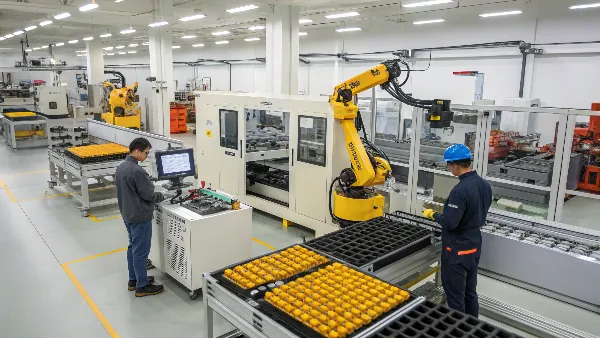
Diving Deeper: The Role of Automation in Cost Reduction
Automation is a powerful lever for cost reduction, especially in higher-volume scenarios or when consistency is paramount. While there’s an upfront investment, the payback can be substantial.
### Robotic Part Removal and Handling:Robots can demold parts with precision and consistency, often faster than human operators. They can then place parts on conveyors, into cooling fixtures, or directly into secondary operation machines (e.g., for trimming or assembly). This reduces the risk of damage and ensures a steady cycle.### Automated Degating and Trimming:If parts require runner removal or flash trimming, automated systems (robots with cutting tools, specialized degating machines) can perform these tasks accurately and quickly, freeing up labor for more value-added work.### Automated Inspection Systems:Vision systems or other sensors can be integrated to inspect parts for defects (shorts, flash, dimensional inaccuracies) in real-time. This catches problems early, reduces scrap, and ensures higher outgoing quality without dedicated manual inspection labor for every part.### When is Automation Cost-Effective?The decision to automate depends on production volume, labor costs, part complexity, and quality requirements. For high-volume, long-running jobs, the ROI is often clear. Even for smaller runs, simple automation like sprue pickers can be beneficial. I always encourage clients like Jacky to discuss automation options with us early in the project. Sometimes, a small design change can make a part much easier to automate, unlocking further savings.
Automation not only cuts direct labor but also contributes to a more stable and predictable manufacturing process.What’s the Secret to Optimizing Cycle Times for Cheaper Injection Molded Parts?
Are long cycle times driving up your unit cost and limiting your production output? Every second shaved off the injection molding cycle can translate into substantial savings over a production run.
Optimizing injection molding cycle times involves meticulous fine-tuning of process parameters like injection speed, packing pressure, cooling time, and mold open/close speed, directly reducing machine time and energy usage per part.

Diving Deeper: Squeezing Seconds, Saving Dollars
Cycle time is a major driver of part cost in injection molding. The faster you can produce good parts, the lower your cost per part. At CavityMold, we’re obsessed with optimizing this.
### Key Parameters Affecting Cycle Time:- Cooling Time: Often the largest portion of the cycle. It depends on part thickness, material, and mold cooling efficiency.
- Injection Time: How long it takes to fill the mold cavity.
- Holding/Packing Time: Pressure applied after filling to compensate for shrinkage.
- Mold Open/Close Time & Part Ejection Time: Mechanical movements of the machine and mold.
### Role of Mold Design (Especially Cooling):This is huge. A well-designed mold with optimized cooling channels (their placement, size, and coolant flow) can dramatically reduce cooling time. Conformal cooling, where cooling channels follow the contour of the part, is an advanced technique that can yield significant cycle time reductions for complex parts.### Material Influence on Cooling and Processing:As mentioned earlier, some materials cool faster than others. The melt flow index (MFI) of a material also affects how easily it fills the mold, potentially allowing for faster injection speeds.### Scientific Molding and Process Monitoring:Using scientific molding principles helps establish the most efficient and stable process window. Continuous monitoring of critical parameters ensures the cycle stays optimized and can flag deviations that might lead to longer cycles or defects. We use this to dial in the sweet spot for every job Jacky sends our way.
Reducing cycle time is not just about speed; it’s about doing it intelligently to maintain part quality and process stability.Can Strategic Sourcing and Supplier Relationships Impact Your Molding Costs?
Are hidden shipping fees and communication barriers with distant suppliers eroding your savings? Sometimes looking beyond the initial quote reveals a more complex cost picture for your injection molded parts.
Strategic sourcing considers the total cost of ownership, not just the molder’s quote. This includes logistics, quality control, communication efficiency, and the value of a reliable partnership, which can significantly reduce overall expenses.
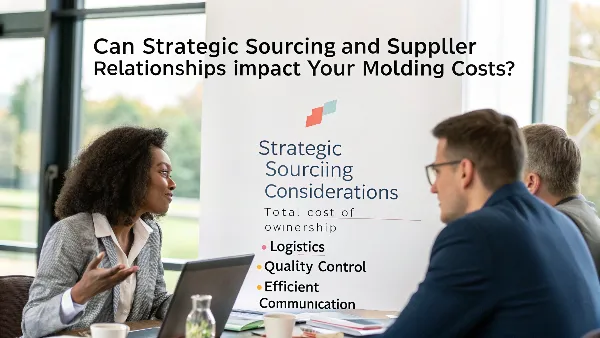
Diving Deeper: Beyond the Price Tag – The Value of a Good Supplier
Choosing a molding partner is a critical decision. While "sourcing locally" is often touted, the key is "sourcing smartly." For many of our North American and European clients like Jacky, partnering with CavityMold in China offers a strong balance of cost-effectiveness and quality, but it requires good management.
### Total Cost of Ownership (TCO):Don’t just compare per-part quotes. Factor in:- Shipping Costs: Distance, weight, and mode of transport can add up.
- Lead Times: Longer lead times mean more inventory holding or potential delays to market.
- Import Duties/Taxes: These can be significant.
- Communication & Travel: Time zone differences and potential travel for audits or issue resolution have costs.
- Quality & Rework: Costs associated with poor quality or parts needing rework can quickly negate initial price advantages.
### The Value of Clear Communication:A supplier who communicates proactively, understands your requirements deeply, and provides quick, transparent feedback is invaluable. This reduces misunderstandings, speeds up problem-solving, and minimizes errors. This is a core part of our service philosophy at CavityMold.### Building a Long-Term Partnership:A strong, trust-based relationship with your molder fosters collaboration. When your molder understands your business and product roadmap, they can proactively suggest DFM improvements, material alternatives, or process optimizations for future projects, leading to ongoing cost savings. Jacky values this partnership approach with us.### Risk Mitigation:A reliable supplier with robust quality systems and contingency plans offers lower risk. Supply chain disruptions or quality escapes can be far more costly than a slightly higher per-part price from a dependable source.
It’s about finding a molder who acts as a true partner in your success.How Can Adopting Lean Manufacturing Principles Trim Fat from Your Molding Budget?
Are inefficiencies like excess inventory, rework, or wasted motion inflating your injection molding costs? Lean thinking focuses on systematically eliminating everything that doesn’t add genuine value.
Lean manufacturing principles applied to injection molding minimize waste in all forms – material, time, movement, defects. This rigorous approach reduces operational costs and boosts overall production efficiency.
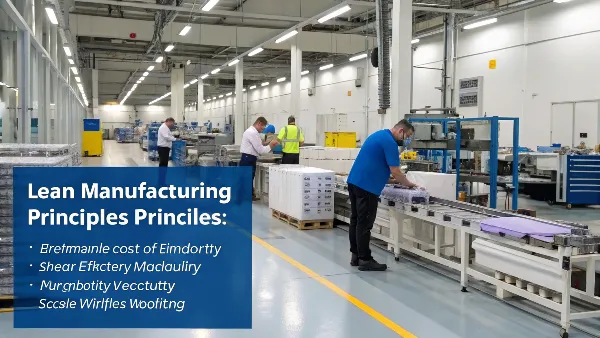
Diving Deeper: Cutting Waste, Boosting Value with Lean
Lean isn’t just a buzzword; it’s a powerful methodology for operational excellence that I’ve seen deliver real results in molding operations. The core idea is to maximize customer value while minimizing waste.
### Identifying and Eliminating the "Seven Wastes" (Muda):- Overproduction: Making more parts than needed, or sooner than needed.
- Waiting: Idle time for machines, materials, or operators.
- Transportation: Unnecessary movement of materials or parts.
- Over-processing: Doing more work to a part than the customer requires.
- Inventory: Excess raw materials, work-in-progress, or finished goods.
- Motion: Unnecessary movement by operators.
- Defects: Parts that need rework or are scrapped.
We constantly look for these in our processes.
### Just-In-Time (JIT) Production:Aiming to produce parts only as they are needed by the next process or the customer. This reduces inventory holding costs and makes problems more visible.### Continuous Improvement (Kaizen):Fostering a culture where everyone is involved in identifying and implementing small, incremental improvements on an ongoing basis. This could be a slightly faster mold change, a better way to pack parts, or a reduction in startup scrap.### Value Stream Mapping:A tool to visualize all the steps in your molding process, from raw material to finished part. This helps identify non-value-added activities and areas for improvement. When Jacky visits, we sometimes walk the floor and discuss this for his projects.
Applying lean principles requires commitment but can transform an operation into a highly efficient, cost-effective system.Could Consolidating Multiple Parts into One Design Reduce Your Overall Costs?
Is managing an assembly of many small components increasing your labor, inventory, and tooling expenses? Sometimes, a clever redesign integrating multiple functions into a single part is a smarter, cheaper approach.
Consolidating several small parts into a single, more complex injection molded component can drastically cut assembly labor, inventory management, tooling for multiple items, and even improve overall product robustness.
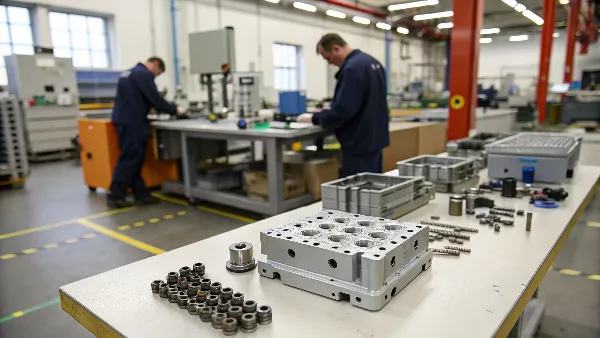
Diving Deeper: The Strategic Advantage of Part Consolidation
I often challenge designers like Jacky to think about part consolidation. While it might make the individual molded part slightly more complex (and thus the mold), the downstream savings can be enormous.
### Key Benefits of Part Consolidation:- Reduced Assembly Costs: Eliminating manual or automated assembly steps is a direct labor saving.
- Lower Inventory & SKU Management: Fewer part numbers to track, store, and manage simplifies logistics.
- Potentially Fewer Molds: If you consolidate three parts into one, you might go from needing three molds to just one, a huge tooling cost saving.
- Improved Part Strength and Reliability: Eliminating joints or interfaces between parts can make the overall assembly stronger and less prone to failure.
- Reduced Procurement Overhead: Sourcing one part instead of many simplifies purchasing.
### Design Considerations for Consolidated Parts:The consolidated part might become more complex, potentially requiring more intricate mold features like slides or lifters. DFM principles are crucial here to ensure the consolidated part is still moldable efficiently. Material selection also becomes critical to ensure all integrated functions are met.### When Does Part Consolidation Make Sense?It’s particularly beneficial for high-volume products where assembly is a significant cost. It also shines when multiple small, related parts can be logically combined without compromising functionality.### Example Scenario:Imagine a housing that previously consisted of a base, a lid, and two internal brackets, all molded separately and then assembled. By redesigning, it might be possible to mold the base with integrated bracket features and have the lid snap directly onto it, reducing four parts to two, or even one if a living hinge is feasible. This is the kind of creative problem-solving we enjoy at CavityMold.
Part consolidation requires a bit more upfront design thinking but can yield impressive long-term cost reductions.Conclusion
Smart strategies in design, materials, tooling, and process optimization can significantly cut injection molding costs without sacrificing quality. CavityMold helps you achieve this, Master Molding Right.
-
Explore this link to discover effective strategies for reducing injection molding costs while maintaining quality, ensuring your business thrives. ↩
-
Learn about DFM principles and how they can simplify designs and reduce costs in injection molding, enhancing your production efficiency. ↩
-
Find out why investing in durable tooling is crucial for long-term savings and quality assurance in injection molding processes. ↩
